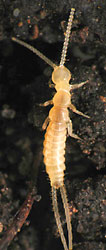| Hexapoda | ||
| Arthropoda | Hexapoda |
| Index | Arthropoda | Atelocerata──?┐
├─►
Pancrustacea─?┘ |
||
| Decapoda | ◄─Insecta |
Insecta |
|
Abbreviated Dendrogram
Mandibulata
├─Myriapoda
└─┬─Crustacea
│
└─Hexapoda
├─┬─Protura
│ └─Collembola (springtails)
└─┬─Diplura
└─Insecta (insects)
|
Contents
|
Taxa on This Page
While crustaceans are the dominant group of arthropods in marine environments, hexapods, including insects, rule the land. Their dominance among animals is evident in their numbers of species, with over 750,000 described (Wilson, 1988), as well as biomass (e.g. Fittkau and Klinge, 1973).

As the name indicates the Hexapoda have six legs, one pair per thoracic segment. The body segments are fused into three body regions: a head, thorax, and abdomen.. A single pair of preoral antennae are present. The waxy epicuticle protects against desiccation. The superclass Hexapoda includes so-called true insects and several orders or classes (depending on your preference) of primitive wingless proto-insects, the Collembola, Protura, and Diplura (Manton 1979). These are soil or litter dwellers. Collembola (springtails) are perhaps the most abundant arthropods on earth. Proturans are very small, pale arthropods that are rarely encountered. Diplurans (right) include a few families of larger, pale arthropods that are frequently found in moist soils. Of the four or so hexapod classes, only the Class Insecta possess wings. DRM 02xxxx ToL, MAK020507, 120515
Image: Campodeid (Diplura), photo Creative Commons Attribution © 2002 David R. Maddison
The oldest well-known fossil hexapod is called Rhyniella praecursor, a collembolan from the Early Devonian-age Rhynie Chert. This and other small, wingless forms may have been an important part of the early terrestrial ecosystem, mainly detritivores foraging in soil and plant litter (the most primitive of the true insects, the Thysanura or silverfish, have a similar lifestyle, and have adapted well to human habitats). By the middle Carboniferous, a number of insect lineages appeared Carpenter 1992, and insects have dominated the terrestrial microfauna ever since.
Morphological and embryological evidence points to the Hexapods being related most closely either to the Myriapods; molecular sequencing and some morphology however argues for Crustacea as the sister group; molecular evidence alone - but not morphology!, - has Crustacea as the parent clade MAK020507, 120515
The position of Diplura in the hexapods is unclear. Traditionally, it has been placed with the Collembola and Protura in a group called "Entognatha",
so named because members of these three orders all have the base of the mouthparts internalized, so that the mandible and maxilla are partly contained within the head capsule. In addition to this derived similarity in mouth structure, these three orders share reduced Malpighian tubules and compound eyes. However, there is some evidence that diplurans may instead be the sister group of insects:
Derived characteristics linking diplurans with insects include the presence of filiform cerci, and an extra set of nine single tubules in the axoneme of the sperm. For a more detailed discussion of the evidence, with additional references, see Kristensen (1991). - DRM 02xxxx ToL
All known recent and fossil hexapods are air breaters. The few aquatic insects are usually able to live in the water by trapping air bubbles against their spiracles (respiratory openings). This shows that they developed from an arthropod group that was already breathing air, although the precise ancestry remains uncertain, as no transitional fossil types are known. Terrestrial arthropods - insects, arachnids, and myriapods, are one of only two groups of animals that are truly adapted to terrestrial life, in that they manage water to an extent that allows them to explore the terrestrial habitat fully; the other being the Amniota vertebrates - MAK120515, adapted from UA Geosciences.
Early Devonian to Recent
Phylogeny: Mandibulata : Myriapoda + (Crustacea + * : (Protura + Collembola) + (Diplura + Insecta))))
Comments: The most distinctive feature of the hexapods is the reduction in walking appendages to six, with three body segments consolidating to form the thorax, which provides much of the locomotory ability of the animals. (n contrast to other arthropods, most of which have more than three pairs of legs.) - David R. Maddison, ToL CC-BY 2002
page MAK120515; Creative Commons Attribution
DRM02 = Text by David R. Maddison, Tree of Life - Hexapoda Creative Commons Attribution 2002;